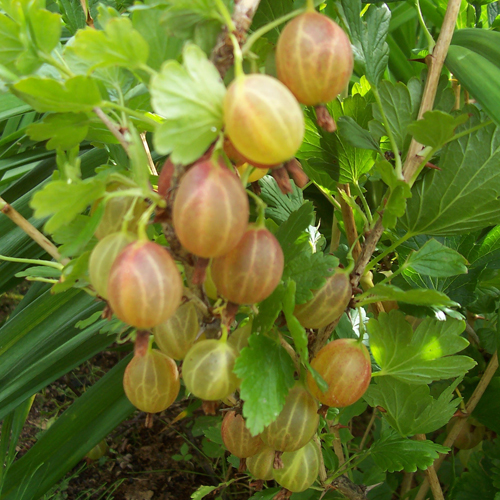Gooseberry variety Rodnik
There are several recipes for the Tsarskoye gooseberry jam. But, in order to cook at least one of them, you need the right variety of gooseberries, with a dense and non-bursting skin. Therefore, housewives who know the tricks of preparing this difficult dessert will choose Spring, among other suitable varieties. And gardeners pay attention to this crop because of its excellent characteristics. The authors of this variety are M.N. Smirnova and I.V. Popov. Parental forms - Lada and No. 329-11 (seedling from self-pollination of the Purmen species). The Rodnik was obtained at the Moscow Fruit and Berry Experimental Station (VSTISP). It was entered into the State Register of Breeding Achievements of Russia in 2002, zoned for the Central Region (Tula, Bryansk, Smolensk, Vladimir, Ryazan, Ivanovskaya, Moscow, Kaluga regions). It is considered promising not only for cultivation in private gardens, but also for industrial cultivation.

Description
Plant of normal vigor, erect, dense, compact, one might say compressed, neat. Young shoots of gooseberries are thick, strong, do not bend under the harvest, the green bark has a slight reddish tan. Woody, the bark turns gray, pubescence is absent, a weak anthocyanin coloration appears only at the top. The degree of prickling of the Spring is moderate - 2 - 3 thorns are distributed over 50 cm of the shoot. Spines are single, rare, dark-colored, matte. Their length is up to 11 mm, the thickness is usual. They grow perpendicular to the shoot in the lower part of it. Most often, thorns are found on young shoots. The buds of the variety are rather large, oblong, brown, growing deviating from the shoot. The apical kidney is solitary.
The leaves are large, bright green, leathery, with a slightly glossy surface. The shape is five-lobed, with shallow notches and blunt tops, the middle lobe rises above the lateral ones. The edge of the gooseberry leaf is slightly wavy, the teeth are large, blunt-pointed. The base is straight. The leaf is horizontal, there is a concavity along the central veins. An additional protrusion is found on the middle lobe. The lateral lobes are widely spaced; the central veins of these lobes are connected at an acute angle. The basal lobes are underdeveloped. The petiole is thick and short. The petiole trace is rounded. Spring's flower cluster consists of one or two large, pale flowers. Sepals are unclosed, moderately bent, light green with reddish-lilac strokes. The ovary of the variety is round, without edges, not pubescent.

Gooseberry fruits are one-dimensional, round-oval, large - 5.0 - 6.7 grams. The calyx is large, oval, closed. The color of the berry is yellowish-green, when fully ripe, a honey tint appears, a reddish tan may be present on the surface. The skin is dense, smooth, with a slight waxy coating. Venation is moderately pronounced. The pulp is juicy, tender, aromatic. The taste is refreshing, dessert, sweet and sour. Tasting score 4.5 points. 100 grams of raw product contains: soluble solids - 11.0%, total sugars - 7.7%, titrated acids - 2.7%, ascorbic acid - 23.0 mg. The peduncle is straight, long.
Characteristics
- The spring is a fast-growing species, fruiting can begin as early as the second year after planting;
- ripening period - early. In late June - early July, you can remove the first ripe berries. Ripening occurs 3 to 4 days earlier than gooseberry Russian;
- according to VNIISPK, the average long-term yield of the variety is 10.3 t / ha or 7.5 kg per bush. Productivity according to the State Register - 92.6 c / ha.According to other sources - 14.4 t / ha;
- frost resistance is excellent. The bush can withstand temperatures as low as -35 ° C. Temperature changes that have often happened in recent years, when the thaw is replaced by frost again, tolerates easily. Cases of damage after winter are quite rare, but if this happens, the plant recovers very quickly;
- drought tolerance can be called satisfactory;
- Rodnik has a high immunity - gooseberries are especially resistant to powdery mildew and septoria. Resistance to anthracnose is average;
- of the pests, most often the trouble is the fire and the shoot aphid;
- with increased dampness, ripe berries can massively crumble;
- self-fertility in the variety is high, it is able to tie and form a crop on its own. But still, with cross-pollination, the quality and quantity of fruits increases;
- transportability is good, fruits do not crumple, do not lose their presentation. But for this, the crop must be harvested at the stage of technical ripeness;
- the way of eating fruits is universal. Having collected the berries, you can use them in their natural form, cook jam, jam, marmalade, freeze.
Planting and leaving
Spring and autumn can be planted with the Spring, depending on climatic conditions. It is advisable to choose a place for gooseberries that is sunny, dry, with loose and nutritious soils that have neutral acidity. The groundwater level should be no higher than 1.5 meters to the surface. The distance to neighboring plants is at least 1 meter. Watering is required moderate, feeding is carried out according to the usual scheme. To maintain a large fruit variety, annual pruning is required. After thinning, the well-lit branches bloom profusely and yield a good harvest. In addition, the risk of fungal diseases and insect infestations is reduced. The culture reproduces well by layering and cuttings.
The spring is especially suitable for the climatic conditions of central Russia. The plant is unpretentious and easy to grow using standard care rules. The variety is valued for its good yield, large fruit size, high frost resistance and good immunity. Thanks to the excellent self-fertility of the gooseberry, you can save space in a small garden, since there is no special need for planting a pollinator. The number of thorns on the plant is small, therefore, during harvesting, the hands practically do not suffer. The only negative is the shedding of fruits in rainy weather.








